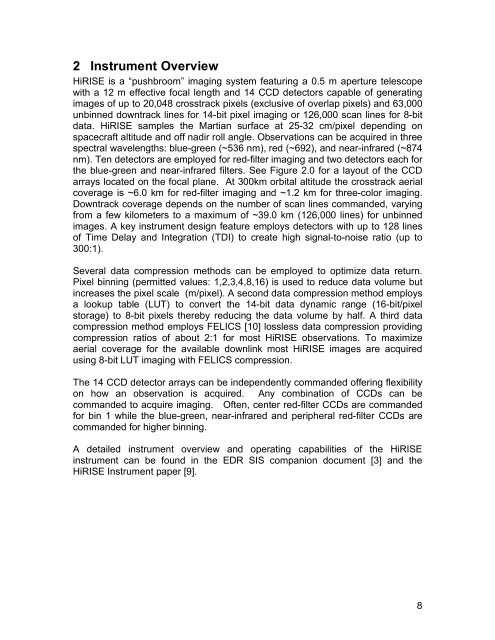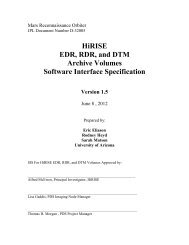Software Interface Specification for HiRISE Reduced Data Record ...
Software Interface Specification for HiRISE Reduced Data Record ...
Software Interface Specification for HiRISE Reduced Data Record ...
You also want an ePaper? Increase the reach of your titles
YUMPU automatically turns print PDFs into web optimized ePapers that Google loves.
2 Instrument Overview<br />
<strong>HiRISE</strong> is a “pushbroom” imaging system featuring a 0.5 m aperture telescope<br />
with a 12 m effective focal length and 14 CCD detectors capable of generating<br />
images of up to 20,048 crosstrack pixels (exclusive of overlap pixels) and 63,000<br />
unbinned downtrack lines <strong>for</strong> 14-bit pixel imaging or 126,000 scan lines <strong>for</strong> 8-bit<br />
data. <strong>HiRISE</strong> samples the Martian surface at 25-32 cm/pixel depending on<br />
spacecraft altitude and off nadir roll angle. Observations can be acquired in three<br />
spectral wavelengths: blue-green (~536 nm), red (~692), and near-infrared (~874<br />
nm). Ten detectors are employed <strong>for</strong> red-filter imaging and two detectors each <strong>for</strong><br />
the blue-green and near-infrared filters. See Figure 2.0 <strong>for</strong> a layout of the CCD<br />
arrays located on the focal plane. At 300km orbital altitude the crosstrack aerial<br />
coverage is ~6.0 km <strong>for</strong> red-filter imaging and ~1.2 km <strong>for</strong> three-color imaging.<br />
Downtrack coverage depends on the number of scan lines commanded, varying<br />
from a few kilometers to a maximum of ~39.0 km (126,000 lines) <strong>for</strong> unbinned<br />
images. A key instrument design feature employs detectors with up to 128 lines<br />
of Time Delay and Integration (TDI) to create high signal-to-noise ratio (up to<br />
300:1).<br />
Several data compression methods can be employed to optimize data return.<br />
Pixel binning (permitted values: 1,2,3,4,8,16) is used to reduce data volume but<br />
increases the pixel scale (m/pixel). A second data compression method employs<br />
a lookup table (LUT) to convert the 14-bit data dynamic range (16-bit/pixel<br />
storage) to 8-bit pixels thereby reducing the data volume by half. A third data<br />
compression method employs FELICS [10] lossless data compression providing<br />
compression ratios of about 2:1 <strong>for</strong> most <strong>HiRISE</strong> observations. To maximize<br />
aerial coverage <strong>for</strong> the available downlink most <strong>HiRISE</strong> images are acquired<br />
using 8-bit LUT imaging with FELICS compression.<br />
The 14 CCD detector arrays can be independently commanded offering flexibility<br />
on how an observation is acquired. Any combination of CCDs can be<br />
commanded to acquire imaging. Often, center red-filter CCDs are commanded<br />
<strong>for</strong> bin 1 while the blue-green, near-infrared and peripheral red-filter CCDs are<br />
commanded <strong>for</strong> higher binning.<br />
A detailed instrument overview and operating capabilities of the <strong>HiRISE</strong><br />
instrument can be found in the EDR SIS companion document [3] and the<br />
<strong>HiRISE</strong> Instrument paper [9].<br />
8




